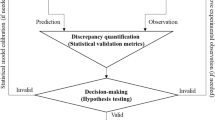Conclusions
ASCI has brought to the fore many important issues related to the ability of computational simulations to predict the response of a wide variety of complex engineered systems. The building blocks of our confidence assessment are verification of computer codes and validation of computational models. We contend that a new type of experiment, a validation experiment, is needed so that more quantifiable statements of level of agreement between computational results and experimental data can be made. Only with experimentalists and computational analysts working closely together can we better understand the limits of computational models and improve our experimental capabilities. We must also improve our understanding of how validation evidence for our computational models can be used to quantify our assessment of prediction accuracy.
Similar content being viewed by others
References
DOE, “Accelerated Strategic Computing Initiative (ASCI) Program Plan,” Department of Energy, Defense Programs, DOE/DP-99-000010592, Washington, DC, 2000.
AIAA, “Guide for the Verification and Validation of Computational Fluid Dynamics Simulations,” American Institute of Aeronautics and Astronautics, AIAA-G-077-1998, Reston, VA, 1998.
Pilch, M., Trucano, T.G., Moya, J.L., Froehlich, G.K., Hodges, A.L., and Peercy, D.E., “Guidelines for Sandia ASCI Verification and Validation Plans—Content and Format: Version 2,” Sandia National Laboratories, SAND2000-3101, Albuquerque, NM, 2001.
Schlesinger, S., “Terminology for Model Credibility,” Simulation, Vol. 32, No. 3, 1979, pp. 103–104.
Oberkampf, W.L., and Trucano, T.G., “Verification and Validation in Computational Fluid Dynamics,” Progress in Aerospace Sciences, accepted for publication, 2001.
Oberkampf, W.L., and Trucano, T.G., “Validation Methodology in Computational Fluid Dynamics,” American Institute of Aeronautics and Astronautics, AIAA 2000-2549, Fluids 2000 Conference, Denver, CO, 2000.
Oberkampf, W.L., and Aeschliman, D.P., “Joint Computational/Experimental Aerodynamics Research on a Hypersonic Vehicle: Part 1, Experimental Results,” AIAA Journal, Vol. 30, No. 8, 1992, pp. 2000–2009.
Oberkampf, W.L., Aeschliman, D. P., Tate, R.E., and Henfling, J.F., “Experimental Aerodynamics Research on a Hypersonic Vehicle,” Sandia National Laboratories, SAND92-1411, Albuquerque, NM, 1993.
Oberkampf, W.L., Aeschliman, D.P., Henfling, J.F., and Larson, D.E., “Surface Pressure Measurements for CFD Code Validation in Hypersonic Flow,” American Institute of Aeronautics and Astronautics, AIAA Paper No. 95-2273, 26th AIAA Fluid Dynamics Conf., San Diego, CA, 1995.
Aeschliman, D.P., and Oberkampf, W.L., “Experimental Methodology for Computational Fluid Dynamics Code Validation,” AIAA Journal, Vol. 36, No. 5, 1998, pp. 733–741.
Coleman, H.W., and Steele, W.G., Jr., Experimentation and Uncertainty Analysis for Engineers, 2nd ed., John Wiley & Sons, New York, 1999.
Author information
Authors and Affiliations
Additional information
Editors Note: This is the second of a series of articles that describe recent work on computational model validation being conducted at the nuclear weapons laboratories within the Department of Energy This article describes what computational model validation is, and how validation experiments are designed, executed, and analyzed. The next article will present a framework for assessing confidence in computational predictions based on validation experiments. The final article will highlight the application of validation methods within industry and explain how these methods can be applied by the practicing engineer.
Sandia National Laboratories is operated by Lockheed Martin Corp. for the U.S. Department of Energy under contract No. DE-AC04-94AL85000.
Rights and permissions
About this article
Cite this article
Oberkampf, W.L. What are validation experiments?. Exp Tech 25, 35–40 (2001). https://doi.org/10.1111/j.1747-1567.2001.tb00023.x
Published:
Issue Date:
DOI: https://doi.org/10.1111/j.1747-1567.2001.tb00023.x



